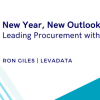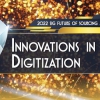Introduction
Advanced data analytics can mean a lot of different things in the business world today, and there’s often a lot of hype that isn't easy to separate from reality. The lower end of the analytics spectrum typically includes a simple comparison of business variables. It then ranges all the way to dynamic advanced analytics leveraging vast amounts of data (often stored and enriched through cloud-based technology platforms) and using emerging technologies such as AI and machine learning algorithms to drive meaningful insights.
The business intelligence (BI) and analytics market is anticipated to grow upwards of 30% annually with global market size reaching over $140B by 2025. The interest fueling these investments largely comes from executive management, sales & marketing, and BI/analytics-related COEs, according to a recent study conducted by Forbes. Senior leaders within the procurement domain are quickly aligning interests with their functional peers by implementing the use of advanced data analytics as one of their top priorities (for more on this, check out “The CPO in the Age of Intelligence” by Ardent Partners or “The Future of Supply Chain Management” by TechTarget and GEP).
As procurement practitioners, we should seek to understand four key dimensions of advanced data analytics in the procurement domain:
- Benefits from data analytics
- Procurement-specific applications
- Analytic frameworks
- Must-know factors
Top 3 Benefits of Leveraging Data Analytics: “Believe It When You See It”
The most powerful benefit of leveraging advanced analytics is superior business decisions across multiple levels of the organization. The seamless exchange of information across organizational levels enables advanced analytics to drive the following outcomes:
- Improved Efficiency in the Operating Model: Advanced analytics is an effective tool for more efficient execution of numerous activities across source-to-pay (S2P) processes. The application of appropriate tools and models can allow for insights through custom dashboards, “guided” execution through AI, and integrated Robotic Process Automation (RPA) to drive deeper efficiencies.
- Savings and Value Generation Opportunities: When designed and implemented correctly, advanced analytics has the potential to generate actionable insights from internal spending data and the impact of external social, economic and market drivers in real time. This amalgamation of internal and external insights also helps create deeper partnerships among business stakeholders who may be looking for support in approaching these disparate sources of information more strategically.
- Mitigating Risk and Fraud: Comprehensive data analytics capabilities can thwart fraud and enhance overall organizational security. Internal and external threats can pose risks to physical, financial and intellectual assets. Predictive fraud analytics models that use statistical tools and relevant category knowledge can reveal fraud trends and drive proactive alerts to form a key component of risk management strategies.
Top 3 Procurement Applications: Moving Concepts to Reality
The decade following the Great Recession was characterized by historically low-interest rates, especially in U.S. and Western European markets. These markets are now battling soaring commodity prices and steadily rising inflation. Procurement leaders are now tasked with generating value while navigating these headwinds. Cutting-edge analytics can provide the fuel for discovering new value-driving opportunities through the following applications:
- CPO “Cockpit”: One major pain point often highlighted by senior procurement executives is limited visibility into key aspects of procurement’s own operating model. The most urgent need is not just for a simplistic “KPI Dashboard,” but rather for a “cockpit approach” outlining key criteria for executives based on data insights to drive better business decisions.
- Cognitive Sourcing: A prominent goal of predictive analytics and machine learning models is to incorporate external market intelligence and benchmarks as an integral component of sourcing and category strategy. These models would allow for fact-based insights around various cost drivers that can be quantified by using statistical modeling techniques and leveraging established market indices.
- “Smart-Sensing” Value Finder: Holistic modeling of the end-to-end value chain allows for value creation opportunities beyond the typical sourcing and negotiations processes. The external market drivers and internal data trends, when modeled appropriately, can guide companies toward making better fundamental business choices that can optimize their cost base.
Analytic Frameworks – Our Own “North Star” for the Analytics Journey
The analytics and insights agenda is very broad, involving numerous tools, platforms and technologies. Companies should look to develop an interconnected ecosystem that is fed through unified technology platforms and can leverage technologies like AI and machine learning to drive insights and business intelligence. The following framework illustrates a continuum of various data analytics models in a company’s ecosystem. Our observation is that having matured in data visualization and scenario modeling areas, many best-in-class companies are focusing their investments on predictive/prescriptive modeling.

Essential Questions
As procurement practitioners embark on their advanced analytics journey, they need to distinguish between information overload and insights generated through robust analytics. Traditional approaches tend to have a myopic focus on information created through dashboards, which is useful but limited in its ability to generate the impact that most companies desire. Here is a list of key questions to consider when evaluating the robustness of any advanced analytics initiative:
- Is the system generating actionable insights or simply providing a visually appealing data aggregation?
- Are reports oriented toward future outlooks and business decisions or using tools and dashboards to repackage historical reporting?
- Are dynamic insights being driven across internal and external market variables or is the information static (point-in-time snapshot)?
- Does the information increase end-to-end visibility across the value chain or is it siloed in a process area?
Leaders in procurement should embrace emerging technologies and advanced analytics as integral parts of their sourcing and business strategy. This is key for staying on the cutting edge of the maturity curve today, as well as essential for future-proofing the organization to meet the needs of tomorrow.
Region:







